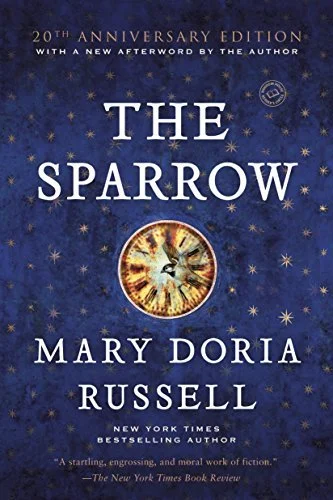The Sparrow by Mary Doria Russel (1996)
Sorry, no exotic cover art this time…
Drawn to this book due to its inclusion in almost all ‘sci-fi meets religion’ lists, The Sparrow proved to be worth the read and I’d love to see more artwork associated with its characters. There’s a good chance this story will make its way into a movie or miniseries someday, one can always hope! Right out of the gates, we are placed at the Arecibo Observatory in Puerto Rico. This brought back memories of how stunning that structure was in its glory days, my first encounter with it appearing in the movie Contact. A quick image search as to the condition of this once grandiose feat of science will give you a morose update on its current state. Thanks hurricanes.
A scientist at Arecibo working for SETI has detected signals near Alpha Centauri and in turn transfers the signals into what is recognizably well crafted alien music. The scientist, along with a female AI expert, a Jesuit priest, and a husband/wife scientist/doctor duo find themselves the lucky candidates for a mission to the stars in search of the signal. The priest, Emilio Sandoz, quickly becomes our central character and the Society of Jesus of which he belongs secretly plots a funded interstellar expedition in search of the music.
The book jumps around between before, during and after the mission to the planet Rakhat. It is revealed early on that Sandoz is the sole survivor of the journey. He has returned physically and mentally broken and is under investigation by the leaders of the church for the possible crimes of murder and prostitution committed while on Rakhat. Crimes so heinous that when Sandoz’s condition was discovered on Rakhat by a second mission and reported back to Earth, the United Nations ran with the story and nearly destroyed the Society of Jesus. Gradually getting to know the details of Sandoz’s experience is when The Sparrow becomes hauntingly addictive. He has returned with his hands meticulously mutilated by a member of the alien race he encountered, the Jana’ata, leaving them inoperable without the aid of mechanical prosthetics. Truly horrifying, the skin and muscles that hold the hand together have been removed all the way to his wrist, in an effort to make his fingers resemble ivy, a ritual the aliens believe teach one about eternal dependence on another. Sandoz’s rehabilitation is brutal, prone to extreme bouts of headaches and vomiting, unable to recount his experience to the Father Superior and a panel of other priests.
Unfortunately, we don’t get to the planet of Rakhat for the details until about 300 pages into the book and at about 450 pages we finally get a detailed explanation by Sandoz to his superiors as to what really happened on Rakhat. As a reader you’ll have to put in some work before you get to the marrow of the bone (sorry Sandoz’s hands, bad choice of words.) The conundrum of traversing such a distance is solved by hitching a ride on an asteroid, mining the rock’s own resources along the way, providing all the materials and fuel needed to make a return trip. Two additional priests join the journey, pilot D.W. and artist Marc, both Jesuits, and the crew eventually make scontact with a small village on Rakhat inhabited by a race called the Runa. Much time passes until they are finally ushered to a larger city and it is here that Sandoz meets a revered individual who is responsible for creating the wonderful music detected on Earth. He is someone whom Sandoz believes will understand the beauty and importance of the concept of God. He eventually suffers a fate much worse than just the destruction of his hands.
“The problem with atheism, I find, under these circumstances,” he continued with academic exactitude, each word etched on the air with acid, “is that I have no one to despise but myself. If, however, I choose to believe that God is vicious, then at least I have the solace of hating God.”
It’s not until Sandoz entirely explains what happened to him on Rakhat that his superiors realize the true horror he’s been through and they themselves are left pondering their own decisions for entering a life devoted to the church. If their God is benevolent, why would he put a man through such trials? The classic answer to this cliché is always explained as some sort of test to be endured, God’s reasons are unknowable so one must rely on faith, right? Within The Sparrow there is plenty of evidence that faith alone is not enough to justify a lifelong devotion to God and the human wreckage of Father Emilio Sandoz embodies an unfortunate example.
